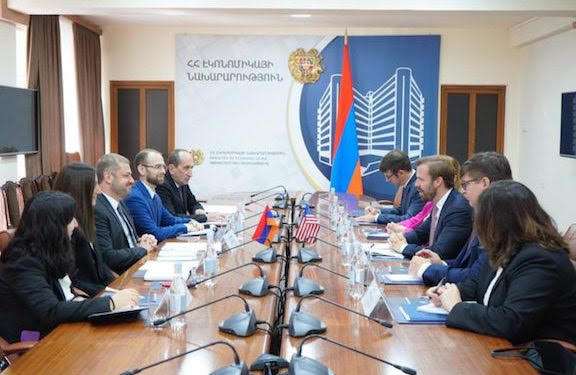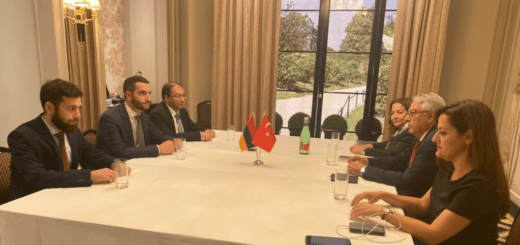Armenia, US Explore New Trade and Investment Prospects

After announcing a $145 million allocation for the implementation of a U.S.-brokered agreement to open a transit route for Azerbaijan passing through Armenia, a senior State Department official had more talks with Armenian officials on Friday to explore new trade and investment avenues between the two countries.
Brendan Hanrahan, the director of the State Department’s European and Eurasian affairs, on Friday held a series of meetings with Armenian officials, among them Economy Minister Gevorg Papoyan and High Tech Minister Mkhitar Hayrapetyan.
The discussions with Papoyan covered prospects for expanding economic cooperation and increasing bilateral trade, a statement from the ministry said.
The two sides reportedly reviewed opportunities to deepen collaboration across several key sectors, including trade and investment, agriculture and food safety, energy, high technologies and innovation, IT and the digital economy, as well as tourism.
“Both parties emphasized the importance of advancing mutually beneficial cooperation and reaffirmed their readiness to continue joint efforts to strengthen economic ties, improve the investment climate, and promote new initiatives,” the statement said.
Papoyan reportedly highlighted Armenia’s strong interest in the TRIPP communication program and proposed developing projects within a public-private partnership framework to attract private investment. He also suggested drafting a detailed roadmap for the program’s implementation.
TRIPP, or the Trump Route for Peace and Prosperity, is the initiative to open a transit route through Armenia’s Syunik Province that the leaders of Armenia and Azerbaijan agreed to in Washington last month.
“The meeting also included an exchange of views on the ‘Crossroads of Peace’ initiative. The Minister stressed that the project is not only aimed at boosting economic connectivity but also at promoting peace and stability in the region, contributing to enhanced regional cooperation and reducing tensions,” the Economy Ministry statement said.
Deputy Minister Anushik Avetian and the U.S. Ambassador to Armenia Kristina Kvien also attended the meeting.
During their meeting, Hanrahan and Mkhitaryan discussed the possibilities for developing coordinated policies in the field of artificial intelligence, implementing investments in Armenia’s semiconductor ecosystem, and developing capabilities for chip design, verification, and testing.
“The sides also touched upon the expansion of U.S. multinational companies’ representation in Armenia, investment promotion, streamlining of export procedures, implementation of R&D projects, as well as the issuance of an export license for Firebird’s infrastructure intended for an AI data center and opportunities for improving existing solutions. Particular emphasis was placed on expanding cooperation in the fields of cybersecurity and space, as well as exploring other potential directions for the further development of Armenia–U.S. relations in the technology sector,” a statement by the high tech ministry said.
Earlier on Friday Hanrahan visited the Dzidzernagapert Armenian Genocide Memorial Complex, where he laid a wreath at the eternal flame and visited the Memorial Wall.

The delegation was welcomed by Edita Gzoyan, Director of the Armenian Genocide Museum-Institute, who accompanied the guests to the memorial, presenting the history of its creation.
Gzoyan also spoke about the three khachkars erected in memory of the Armenians massacred during the late 20th century pogroms in Sumgait, Kirovabad and Baku, as well as about the five freedom fighters, buried near the Memorial Wall, during the Artsakh War, emphasizing the historical link between these events and the Armenian Genocide.
Gzoyan also guided the visitors to the Memorial Wall, where small urns containing soil from the graves of prominent foreign statesmen, public figures, intellectuals, and missionaries — who had raised their voices against the massacres and genocide of Armenians in the late 19th and early 20th centuries — are interred.
She highlighted the efforts of Henry Morgenthau, the U.S. Ambassador to the Ottoman Empire during the genocide, and Clara Barton, founder of the American Red Cross, noting that thanks to their work, the American public was well informed about the atrocities. Gzoyan stressed that the recognition of the Armenian Genocide by the United States was also a tribute to their legacy.





